Hassani S. Mathematical Physics: A Modern Introduction to Its Foundations
Подождите немного. Документ загружается.

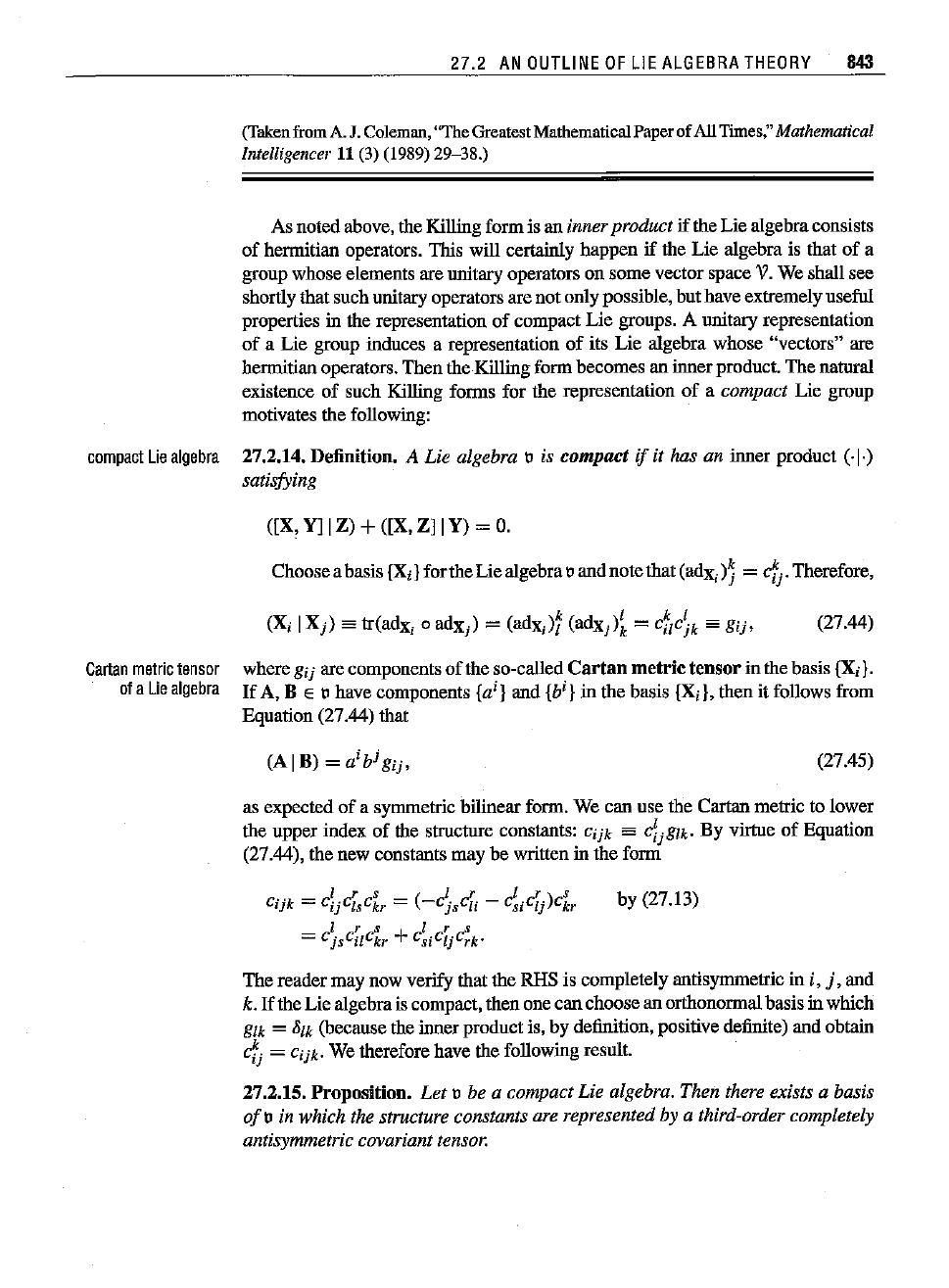
27.2
AN
OUTLINE
OF
LIE
ALGEBRA
THEORY
843
(Taken
from
A.J.
Coleman,
"The
Greatest
Mathematical
Paper
ofAll
Times,"
Mathematical
Intelligencer 11 (3) (1989) 29-38.)
As noted above, the Killing form is an innerproduct
if
the Lie algebraconsists
of
hermitian operators. This will certainly happen
if
the Lie algebra is that
of
a
group whose elements are unitary operators on some vector space
V.We shall see
shortly thatsuch unitary operators are not onlypossible, but have extremelyuseful
properties in the representation
of
compact
Lie
groups. A unitary representation
of
a Lie group induces a representation
of
its Lie algebra whose "vectors'; are
hermitianoperators. Then the
Killing
form becomes an innerproduct. The natnral
existence
of
such Killing forms for the representation
of
a compact Lie group
motivates the following:
compact
Lie
algebra
27.2.14. Definition. A Lie algebra Uis
compact
if it has an inner product (·1·)
satisfying
([X, Y]
1Z) +([X, Z] 1Y) =
O.
Choosea basis {Xi} for the Lie algebraUand notethat
(adx,)j
=
cfj'
Therefore,
(27.44)
(27.45)
Cartan
metric
tensor
ofa
Lie
algebra
where gij are components
of
the so-called
Cartan
metric
tensor
in the basis {Xii.
If
A, B E U have components {a
i}
and {b
i}
in the basis {Xi}, then it follows from
Equation (27.44) that
(A
1
B)
=
aib
j
gij,
as expected
of
a symmetric bilinear form. We can use the Cartan metric to lower
the upper index
of
the structnre constants: Cijk es
C!jglk.
By virtue
of
Equation
(27.44), the new constants may
be written in the form
by (27.13)
The reader may now verify that the RHS is completely antisymmetric in
i,
j,
and
k.
If
the Lie algebrais compact, then one
can
choosean orthonormalbasis in which
glk
= 81k (because the inner productis, by definition, positive definite) and obtain
cfj =
Cijk-
We therefore have the following resnlt.
27.2.15.
Proposition.
Let
Ube a compactLie algebra. Then there exists a basis
of
U in which the structure constants are represented by a third-order completely
antisymmetric
covariant tensor.

844 27. LIE
GROUPS
AND
LIE
ALGEBRAS
27.2.16.
Example.
We can calculate explicitly the Killing form of the Lie algebras
glen, lR) and olen,
R).
Choose the Weylbasis introducedin Example
27.2.7
and expand
A, B E
g(n,
lR) in termsof the Weyl basis vectors: A =
aij
eij.
B =
hi}
ef}.
The
Cartan
metric tensor becomes
gij,kl =
ciJ.mnck}~rs
=
(~jm8[
8~
-
8in8:-ntSj)
(81
r
tS
r
8
: - 8ks
8
:'8i),
wherewe have used Equation(27.29). It
follows
from these relations,Equation(27.45),
and a
simple
index
manipulation
that
(AIB)
==
a
ij
bkl
gij,kl
= 2n tr(AB) - 2tr Atr B
for A,BE glen, R), and
(AIB) = 2n tr(AB)
forA, B E sl(n,
R),
becauseall matricesin sl(n,
JR.)
are traceless.
(27.46)
(27.47)
III
(27.48)
semisimple
Lie
algebras
A Lie algebra n, as a vector space,
may
be written as a direct sum
of
its
snbspaces. We express this as
r
U =UI + U2 +
...
+ U
r
=L
+Uk.
k=l
If
in addition {Uk}are Lie subalgebras every one
of
which commutes with the rest,
we write
r
U=UI
Ell
U2
Ell
...
Ell
U
r
= L
EIl
u
k
k=l
and say that Uhas been
decomposed
into a direct
sum
of
Lie algebras. In this case,
each
Uk is not only a subalgebra, but also an ideal
of
Uas the reader may verify.
The
study
of
the structure
of
Lie algebras boils down to the study
of
the "sim-
plest"kind
of
Lie algebrasin terms
of
whichotherLie algebrascan be decomposed.
Intuitively, one would wantto call a Lie algebra"simple"
if
it has no proper subal-
gebras. However, in terms
of
decomposition, such subalgebras are required to be
ideals. So the natural definition
of
a simple Lie algebra wouldbe the following:
27.2.17. Definition.
A Lie algebra that has no proper ideal is called a simple
Lie algebra. A Lie algebra is semisimple
ifit
has no (nonzero) commutative ideal.
For
example, the pseudo-orthogonal algebra
o(p,
n - p) is setuisimple, but
the Poincare algebra p
(p,
n -
p)
is not because the translation generators Pj form
a commutative ideal.
A useful criterionfor semisimplicity is given by the following theorem due to
Carlan, which we state without
proof
(for a proof, see [Baru 86, pp. 15-16]):
27.2.18.
Theorem.
(Carlan)A Lie algebra Uissemisimple
if
and
only
if
det (gij)
oF
o.

Cartan
subalgebra
andthe
rank
ofa
Lie
algebra
27.3
REPRESENTATION
OF
COMPACT
LIE
GROUPS
845
The
importance
of
semisimpleLie algebras is embodied [Barn 86, pp. 19-20].
27.2.19.
Theorem.
(Carlan) A semisimple complex or real Lie algebra can be
decomposed into a direct sum
of
pairwise orthogonal simple subalgebras. This
decomposition is unique up to ordering.
The orthogonalityis with respecttothe Killing form. Theorem 27.2.19reduces
the study
of
semisimple Lie algebras tn that
of
simple Lie algebras. What about
a general Lie algebra
U?
If
U is compact,
then
it
turns out that it can he written
as
U = 3 Ell5 where 3 is the center
of
U and 5 is semisimple.
If
U is not compact,
thenthe decomposition will
not
be in terms
of
a direct sum,
but
in terms
of
what
is
called a
semidirect sum
one
of
whose factors is semisimple.
For
details, the reader
is referred to the fairly accessibletreatment
of
Barut and Raczka, Chapter I.
From
now on we shall restrict our discussionto semisimpleLie algebras. These algebras
are completely known, because simple algebras have been completely classified.
We shall not pursue the classification
of
Lie algebras. However, we simply state a
definition that is used in such a classification, because we shall have an occasion
to use it in the representation theory
of
Lie algebras.
27.2.20. Definition.
Let
Ube a Lie algebra. A subalgebra
~
of»
is calleda Cartan
subalgebra
if~
is the largest commutative subalgebra
of
»,
and
for
all X E
~,if
adx leaves a subspace
of»
invariant, then it leaves the complement
of»
invariant
as well. The dimension
of~
is called the
rank
of».
27.3 Representation
of
Compact Lie Groups
Representation
of
general Lie groups is closely related to representation
of
their
Lie
algebras, and we shall discuss
them
in the next two sections. In this section,
however, we shall consider the representation
of
compactLie groups, because for
such groups, many of the ideas developedfor finite groups hold. Beforediscussing
compact groups, let us state a definition and a proposition that hold for
all Lie
groups.
27.3.1. Definition.
A representation
of
a Lie group G an a Hilbert space
1f
is
a Lie group homomorphism T :
G -->
GL(1f).
Similarly, a representation
of
the
Lie algebra
9 is a Lie algebra homomorphism X : 9 -->g[(1f).
The proposition we have in mind is the important
Schur's
lemma
which we
state without
proof
(for a
proof
see [Barn 86, pp. 143-144]).
Schur's
lemma
27.3.2.
Proposition.
(Schur'slemma)A unitary representation T : G -->
GL(1f)
of
a Lie group G is irreducible ifand only ifthe only operators commuting with
all the
Tg are scalar multiples
of
the unit operator.

846 27. LIE
GROUPS
ANO
LIE
ALGEBRAS
27.3.3.
Example.
COMPACTNESS
OF
U(n), O(n), 8U(n),
AND
80(n)
Identify
GL(n,
C) with
]R2n
2
via components. Themap
/ :
GL(n,
<C)
-e-
GL(n,
iC) given by
All
representations
of
compact
groups
can
be
made
unitary.
is
continuous
becauseit is simply the
products
of elementsof
matrices.
It follows that ,
/-1
(1)is closed,
because
the
matrix
1is a single
point.
in
]R2n
2
•
whichis
therefore
closed.
/-1(1)
is alsobounded, because
n n
L
aijakj
=
fJik
=}
L
laij
1
2
= n.
j=l
.
i,j=l
Thus,
/-1(1)
is a (2n
2
-I)-dimensional
sphere of radius
,;n
in
]R2n
2
,
which is clearly
bounded. The BWHB theorem (of Chapter 16) now implies that
/-1(1)
is compact. Now
note that
1-1(1) consists of all matrices thathavetheir
hermitian
adjoints
foran
inverse;
buttheseareprecisely theset U(n) of
unitary
matrices.
Now
consider
the
map
det :
U(n)
-+
C. Thismapis also
continuous,
implying
that
det'"
1
(I)
is a closed subsetof U(n). The boundedness of U(n) implies that
det'"
1
(I) is also
bounded. Invoking the BWHB theorem again, we conclude that
det'"
1
(I)
= 8U(n), being
closedand
bounded,
is
compact.
If
instead
of
complex
numbers,
we
restrict
ourselves tothereals,0 (n) andSO(n) will
replace U(n) and8U(n),respectively. III
The
result
of
the
example
above
can
be
summarized:
27.3.4.
Box.
The unitary U(n), orthogonal O(n), special unitary SU(n),
and special orthogonal
SO(n)
groups are all compact.
We
now
start
our
study
of
the
representations
of
compact
Lie
groups. We first
show
that
we
can
always
assume
that
the
representation
is unitary,
27.3.5.
Theorem.
Let T : G -->
GL(X)
be any representation
of
the compact
group G. There exists a new inner product in
1C
relative to which T is unitary.
Proof
Let
( I)
be
the
initial
inner
product.
Define
a
new
inner
product
( I)
by

27.3
REPRESENTATION
OF
COMPACT
LIE
GROUPS
847
where d/-'g is the
Haar
measure, which is
both
left-and
right-invariant. The reader
may check that this is iudeed an inuer product.
For
every h E G, we have
(ThuITh
V)
=
fa
(T
g
ThUITg
ThV)dl-'g
=
fa
(TghUITghV)dl-'g (because T is a representation)
=
fa
(TghUITghV)dl-'gh (because
I-'g
is right invatiant)
=
(a]u).
This shows that
This
unitary for all h E G. D
(27.49)
Weyl
operator
fora
compact
Lie
group
From
nowon,weshall
restrict
ourdiscussionto
unitary
representations
of
compact
groups.
The study
of
representations
of
compact groups is facilitated by the following
construction:
27.3.6. Definition. Let T : G -->
GL(J{)
be a unitary representation
of
the
compact group
G and Iu) E X a fixed vector. The Weyl operator K
u
associated
with'lu) is defined as
Ku
= faiTgU) (Tgul dl-'g.
The essential properties
of
the Weyl operator are summatizedin the following:
27.3.7. Proposition.
Let
T : G -->
GL(X)
be a unitary representation
of
the
compact group
G. Then the Weyl operator has the following properties
1. K
u
is hermitian.
2. K
u
T
g
= T
g
K
u
for all g E G. Therefore, any eigenspace
ofK
u
is an invariant
subspace
of
all T
g'
s.
3. K
u
is a Hilbert-Schmidt operator.
Proof
Statement
(I),
in the form (wi K
u
Iv)'
= (vi K
u
Iw), follows directly from
the definition.
(2)
From
r,
fa
ITxu) (Txul dl-'x =
fa
IT
g
Txu) (Txul dl-'x' the fact that T is a
representation (therefore,
T
g
T
x
= T
gx),
and
redefining the integration vatiable to
y = gx ; we
get
TgK
u
= rITyu) (Tg-1yul dl-'g-ly = rITyu) (Tg-1Tyul dl-'y,
Ja
~
Ja
=dJL
y
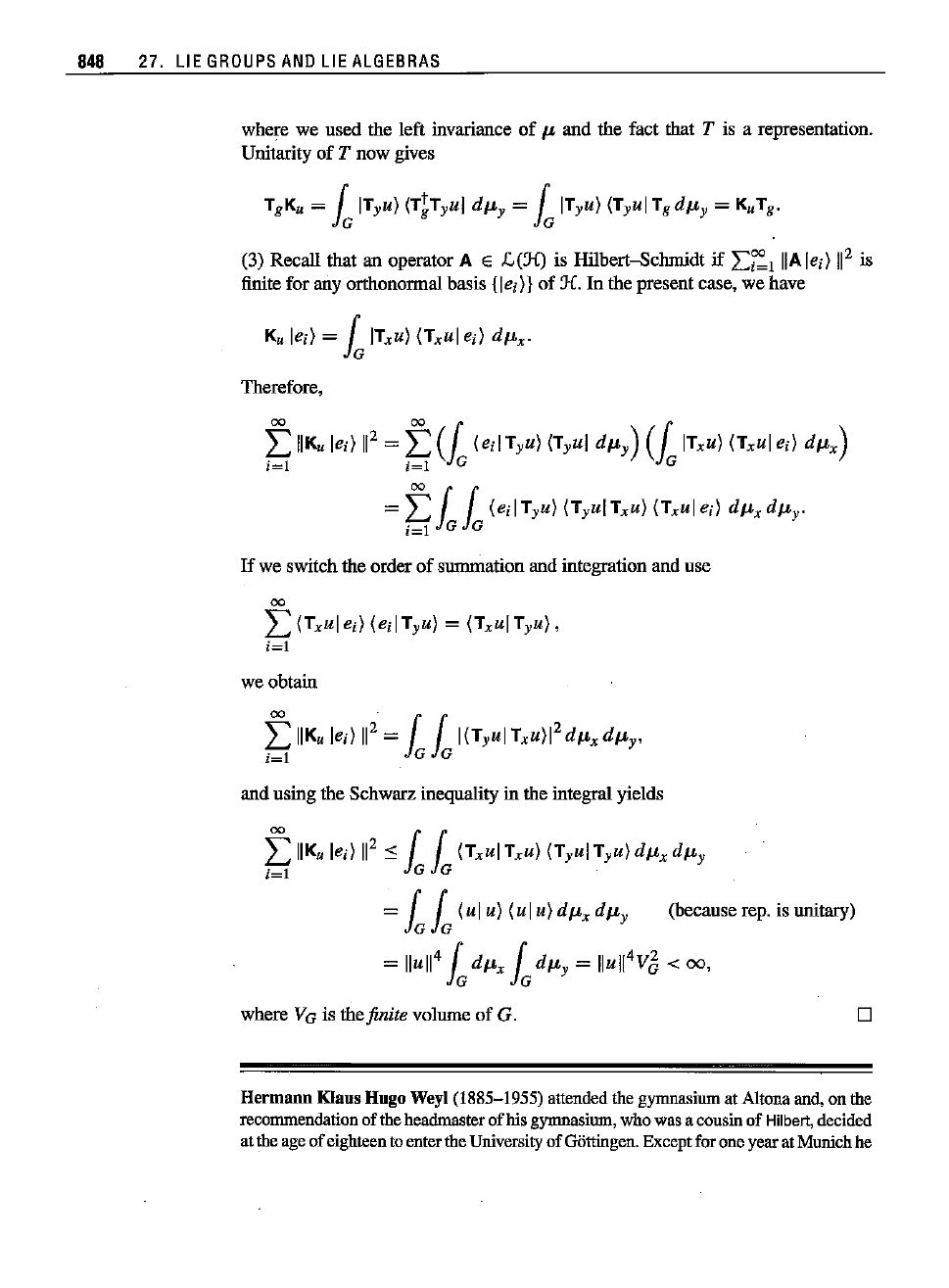
848 27. LIE
GROUPS
AND
LIE
ALGEBRAS
where we used the left invariance
of
f.L
and the fact that T is a representation.
Unitarity of
T now gives
TgK
u
= LITyu) (T;Tyul
df.Ly
= LITyu) (TyuITgdf.Ly = KuT
g.
(3) Recall that an operator A E £.(J£) is Hilbert-Schmidt
if
L~l
IIA
lei)
11
2
is
finite for any orthonormal basis
{lei}}
of J£. In the present case, we have
K
u
lei) = LITxu) (Txul ei)
df.Lx·
Therefore,
f:
IIK
u
lei}
11
2
=
f:
(1
(eil
Tyu) (Tyul
df.L
y)
(lITxU)
(Txul ei) df.Lx)
i=l
i=l
G G
=
f:
rr(eil Tyu) (Tyul Txu) (Txul et)
df.L
x
df.L
y.
i=l
Ja Ja
If
we switch the order of summation and integration and use
00
L (Txul ei) (eilTyu) = (Txul
Tyu),
i=l
we obtain
and using the Schwarz inequality in the integral yields
f:
IIK
u
lei)
11
2
:s:
rr(Txul Txu) (Tyul Tyu)
df.L
x
df.L
y
i=l
Ja Ja
=
LL
(ulu)
(ulu}df.Lxdf.Ly (because rep. is unitary)
=
lIull
4
L
df.Lx
L
df.Ly
=
lI
ull
4
Ya<
00,
where YG is the finite volume of G.
D
Hermann Klaus HugoWeyl(1885-1955) attended the
gymnasium
at Altonaand,onthe
recommendation ofthe
headmaster
afhis
gymnasium,
whowasacousinof
Hilbert,
decided
attheageofeighteento
enter
theUniversity of Gottingen. Exceptforoneyearat
Munich
he
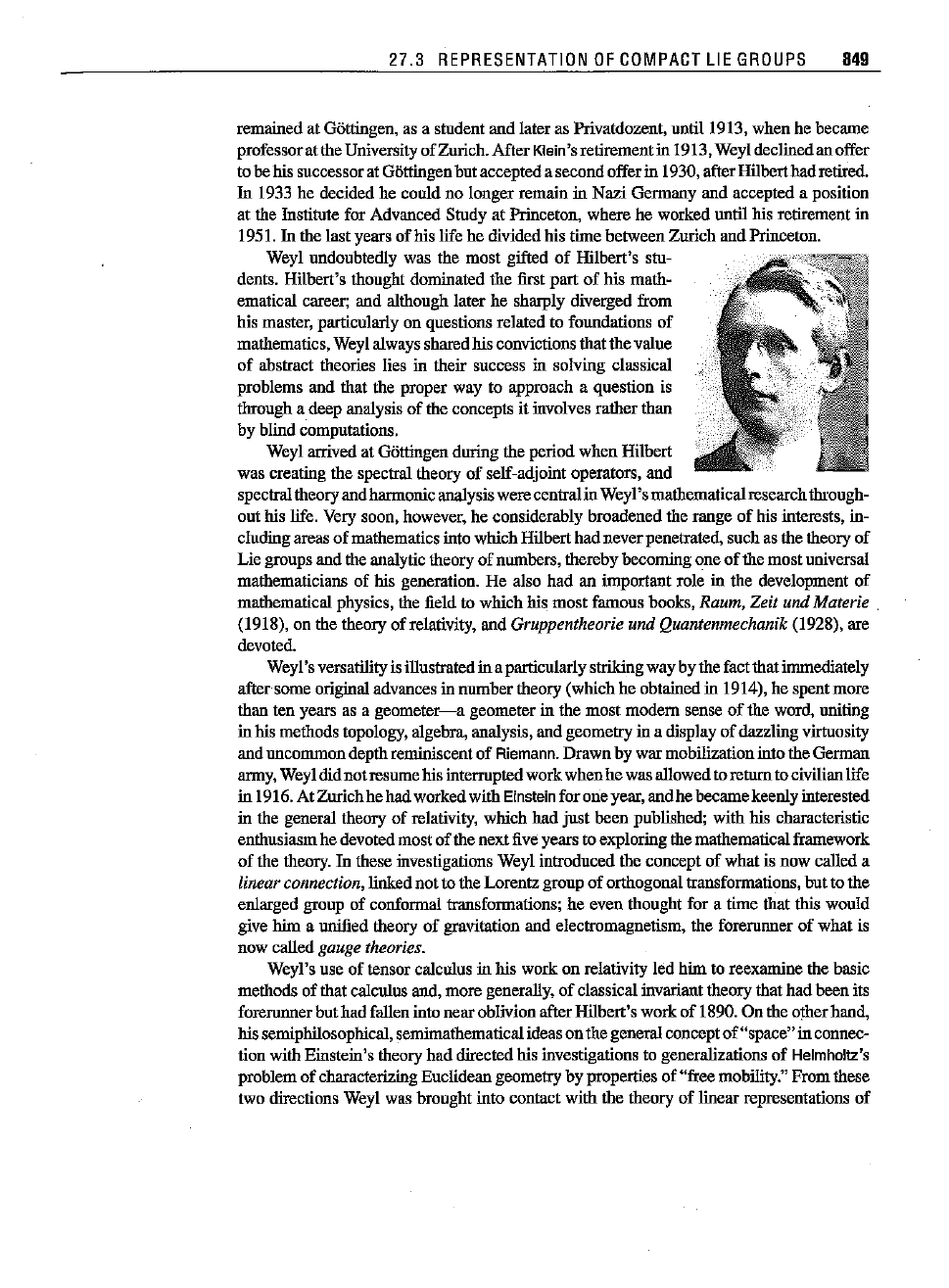
27.3
REPRESENTATION
OF
COMPACT
LIE
GROUPS
849
remained at GOttingen, as a student
and
later as Privatdozent, until 1913.
when
he
became
professorattheUniversityofZurich.After
Klein's
retirementin 1913,Weyldeclinedan offer
to be his successorat Gottingen
but
accepteda secondofferin 1930, after
Hilberthad
retired.
In
1933 he decided he could no longer remain in
Nazi
Gennany
and
accepted a position
at the Institute for Advanced Study at Princeton,
where
he worked until his retirement in
1951.
In
the last years
of
his life he divided his
time
between
Zurich
and
Princeton.
Weyl undoubtedly was the
most
gifted
of
Hilbert's stu-
dents. Hilbert's thought dominated
the
first
part
of
his math-
ematical career; and although later he sharply diverged from
his master, particularly on questions related to foundations
of
mathematics,weyl always sharedhis convictions
that
the
value
of
abstract theories lies in their success in solving classical
problems
and
that the proper way to approach a question is
through a
deep
analysis
of
the concepts it involves
rather
than
by blind computations.
Weyl arrived at Gottlngen during the period
when
Hilbert
was creating the spectral theory
of
self-adjoint operators,
and
spectraltheory
and
harmonicanalysiswere
centralin
Weyl'smathematicalresearchthrough-
out
his life. Very soon, however, he considerably
broadened
the
range
of
his interests, in-
cludingareas
of
mathematics into
which
Hilbert
had
never
penetrated, such as the theory
of
Lie groups
and
the analytic theory
of
numbers,
thereby
becoming
one
of
the
most
universal
mathematicians of his generation. He also
had
an important role in
the
development
of
mathematical physics, the field to
which
his
most
famous books, Raum, Zeit und Materie .
(1918), on the theory
of
relativity, and Gruppentheorie und Quantenmechanik (1928), are
devoted.
Weyl'sversatilityis illustratedin a particularlystrikingway by the fact
that
immediately
after
some original advances in
number
theory (which he obtained in 1914), he spent
more
than ten years as a
geometer-a
geometer in the
most
modem
sense
of
the word, uniting
in his methods topology, algebra, analysis, and geometry in a display
of
dazzling virtuosity
and
uncommon
depthreminiscent
of
Riemann.
Drawn
by war mobilization
into
the
German
army, Weyl did
not
resumehis interrupted
work
when
he was allowedto returnto civilianlife
in 1916. At Zurichhe
had
workedwith Einsteinfor one year,
and
he
became
keenlyinterested
in the general theory
of
relativity,
which
had
just
been
published;
with
his characteristic
enthusiasmhe devoted most
of
the
nextfive years to exploringthe mathematicalframework
of
the theory. In these investigations Weyl introduced the concept
of
what
is
now
called a
linear connection, linked
not
to
the
Lorentzgroup
of
orthogonal transformations,
but
to
the
enlarged group
of
conformal transformations; he even thought for a time that this would
give
him
a unified theory
of
gravitation
and
electromagnetism,
the
forerunner
of
what
is
now called
gauge theories.
Weyl's use of tensor calculus in his
work
on relativity led
him
to reexamine the basic
methods of that calculus and,
more
generally,
of
classical invariant theory
that
had
been
its
forerunner
but
had
fallen into
near
oblivion after Hilbert's
work
of
1890. On the otherhand,
his semiphilosophical, semimathematicalideason the generalconcept
of
"space"
in connec-
tion with Einstein's theory
had
directed his investigations to generalizations
of
Helmholtz's
problem
of
characterizing Euclidean geometry by properties of
"free
mobility."
From
these
two directions Weyl was brought into contact
with
the theory
of
linear representations
of
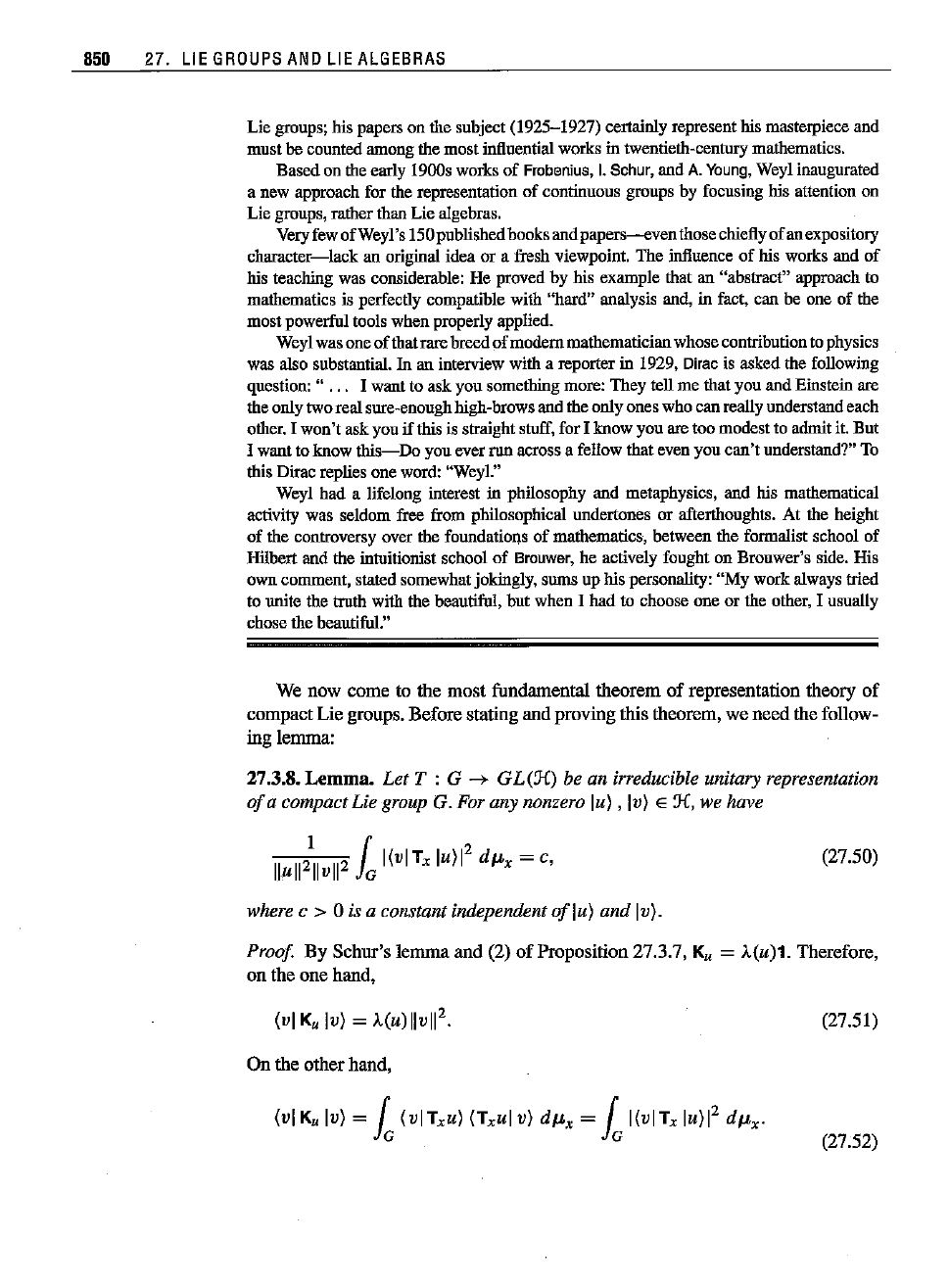
850
27. LIE
GROUPS
AND
LIE
ALGEBRAS
Lie groups; his papers on the subject (1925-1927) certainly represent his masterpiece and
must
becounted among the
most
influential works in twentieth-century mathematics.
Based
on the early 19008 works
of
Frobenius, I.Schur,
and
A.Young,Weyl inaugurated
a new approach for the representation
of
continuous groups by focusing his attention on
Lie groups, rather than Lie algebras.
VeryfewofWeyl's150publishedbooksandpapers-eventhosechieflyofanexpository
character-lack an original idea or a fresh viewpoint. The influence of his works and of
his teaching was considerable: He proved by his example that an "abstract" approach to
mathematics is perfectly compatible with
"hard"
analysis and, in fact, can be one of the
most
powerful tools
when
properly applied.
Weyl was one
of
that rarebreed
of
modem
mathematicianwhose contributionto physics
was also substantial. In an interview with a reporter in 1929, Dirac is asked the following
question: " .
..
I want to ask
you
something more: They tell me that you and Einstein are
the onlytwo realsure-enoughhigh-browsand the
only
ones who can reallyunderstandeach
other. I
won't
ask you
if
this is straight stuff,
forI
know you are too modestto admit it.
But
I want to know
this-Do
you ever run across a fellow that even
you
can't
understand?" To
this Dirac replies one word: "Weyl."
Weyl had a lifelong interest in philosophy and metaphysics, and his mathematical
activity was seldom free from philosophical undertones or afterthoughts. At the height
of
the controversy over the foundations
of
mathematics, between the formalist school of
Hilbert and the intuitionist school
of
Brouwer,he actively fought on Brouwer's side. His
own comment, stated somewhatjokingly, sums up his personality:
"My
work always tried
to unite the truth with the beautiful, but when I
had
to choose
one
or the other, I usually
chose the beautiful."
We now come to the
most
fundamental theorem
of
representation theory
of
compact
Lie
groups. Before stating and proving this theorem, we
need
the follow-
ing lemma:
27.3.8.
Lemma.
Let T : G
......
GL(1f) be an irreducible unitary representation
of
a compactLie group G. For any nonzero lu) , Iv) E
1f,
we have
(27.50)
where c > 0 is a constant independent
oflu)
and
[u).
Proof. By Schur's
lemma
and
(2)
of
Proposition 27.3.7, K
u
= ).(u)1. Therefore,
on the one hand,
(27.51)
On the other hand,
(27.52)
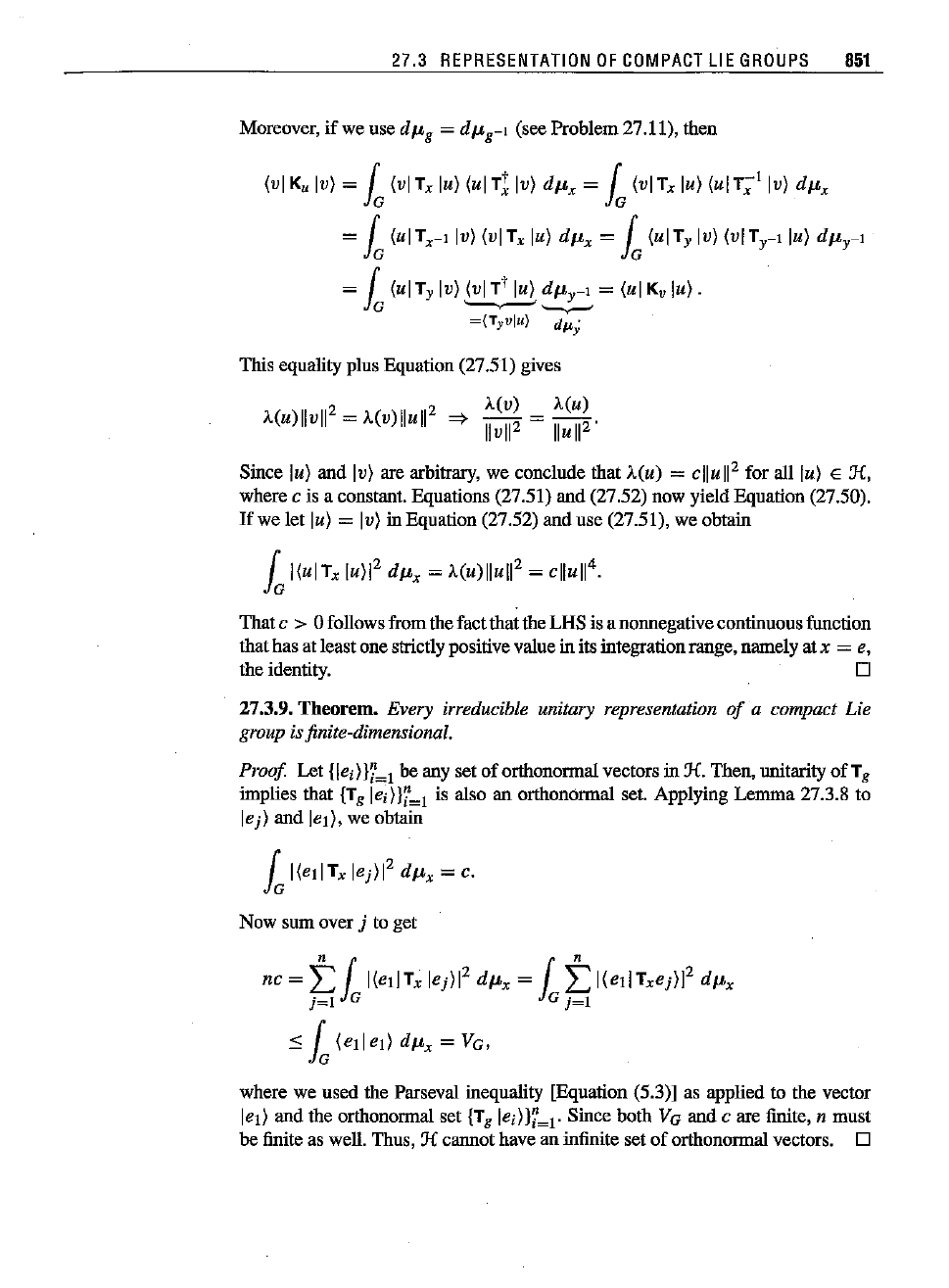
27.3
REPRESENTATION
OF
COMPACT
LIE
GROUPS
851
Moreover,
if
we use
a,..
=
a"g-l
(see Problem 27.11), theu
(vi K
u
Iv)
=
fa
(vi
r,
lu) (ul
Tll
v)
a,.x
=
fa
(vi r, lu) (ul
T;l
Iv)
a,.x
=
fa
(uITx-llv)
(vlT
x
lu)
a,.x
=
fa
(ulT
y Iv)
(vITy-llu)
a"y-l
= { (ulT
y
[u) (vi rt lu)
a"y-l
=(ul K
v
lu).
J
a
'-.-'
'-v-'
=(Tyvlu)
dp,;
This equality plus Equation (27.51) gives
2 2 A(V) A(U)
A(u)lIvll = A(v)lluli
=}
11vII2
= lIull
2'
Since lu) and Iv) are arbitrary, we conclude that A(U) =
clluf
for all la) E J/:,
where c is a constant. Equations (27.51) and (27.52) now yield Equation (27.50).
If
we let lu) = Iv) in Equation (27.52) and use (27.51), we obtain
fa
I(ul
r,
lu)1
2
a,.x
=A(u)lIuIl
2
= cllull
4
.
That c > 0 follows from the fact that the LHS is a nonnegative continuousfunction
that has atleast one strictly positive value in its integrationrange, namely at
x = e,
the identity. D
27.3.9.
Theorem.
Every irreducible unitary representation
of
a compact
Lie
group is finite-dimensional.
Proof
Letllei)
Ji'=l
be any set of orthonormal vectors in
J{.
Then, unitarity
ofT.
implies that {T.
lei)Ji'=1
is also an orthonormal set. Applying Lemma 27.3.8 to
lej) and lei). we obtain
fa
l(ellT
x
lej)1
2
d,.x
= c.
Now sum over j to get
nc =
~
fa
I(ell
r,
lej)1
2
d,.x
=
fa
~
l(e1l Txej)1
2
d,.x
.s
fa
(ellel)
d,.x
= VG,
where we used the Parseval inequality [Equation (5.3)] as applied to the vector
leI) and the orthonormal set {T. lei)}i'=l' Since both VG and c are finite, n must
be finite as well. Thus, J/: cannothave an infinite set
of
orthonormal vectors. D
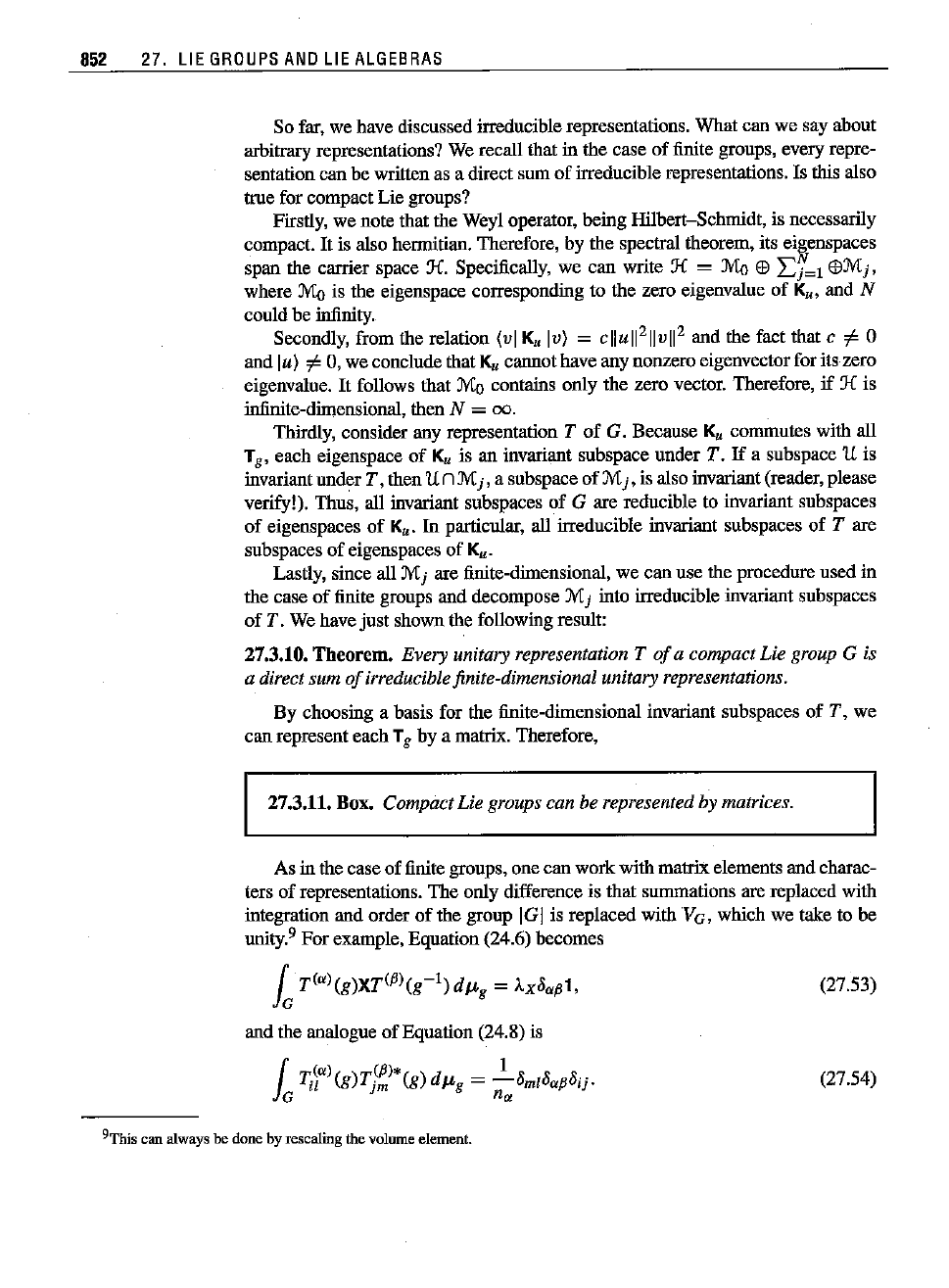
(27.54)
(27.53)
852 27.
LIE
GROUPS
ANO
LIE
ALGEBRAS
So far. we have discussed irreducihlerepresentations. What can we say about
arbitrary representations? We recall that in !he case of finite groups. every repre-
sentation
canbe
written
asadirectsumof
irreducible
representations.
Isthisalso
true for compactLie groups?
Firstly. we note !hat !he Weyl operator. being Hilbert-Schmidt. is necessarily
compact.
It
is also hermitian. Therefore. by the spectral theorem, its
eij&enspaces
span !he carrier space JL Specifically. we can write X =
Mo
Ell
Lj=l
EIl:M
j.
where
Mo
is !he eigenspace corresponding to !he zero eigenvalue of K
u•
and N
could be infinity.
Secondly. from !he relation
(vi
K
u
[u) =
cllull
211vll2
and !he fact !hat c
"i-
0
and
lu)
"i-
O.we conclude!hat K
u
cannot have any nonzero eigenvector for its zero
eigenvalne.
It
follows !hat
Mo
contains only !he zero vector. Therefore.
if
X is
infinite-dimensional. !hen
N =
00.
Thirdly. consider any representation T of G. Because
Ku
commutes wi!h all
Tg. each eigenspace
of
K
u
is an invariant subspace under T.
If
a subspace 'Uis
invariant under T. !hen
'U
n:M
i» a subspace of:M
j.
is also invatiant(reader. please
verify!). Thus. all invatiant subspaces of G are reducible to invariant subspaces
of eigenspaces
of
K
u.
In
particular. all irreducible invatiant subspaces of T are
subspaces of eigenspaces of K
u.
Lastly. since all :M
j are finite-dimensional. we can use !he procedure used in
!he case
of
finite groups and decompose :Mj into irreducible invatiant subspaces
of T. We have just shown !he following result:
27.3.10.
Theorem.
Every unitary representation T
of
a compact Lie group G is
a direct sum
of
irreducible finite-dimensional unitary representations.
By choosing a basis for !he finite-dimensional invatiant subspaces of
T. we
can represent each Tg by a matrix. Therefore.
27.3.11. Box. Compact Lie groups can be represented by matrices.
As in !he case of finite groups. one can work wi!h matrix elements and charac-
ters of representations. The ouly difference is !hat summations are replaced wi!h
integration and order
of
the group IGI is replaced wi!h Va. which we take to be
unity.? For example. Equation (24.6) becomes
fa
T(a)(g)XT(~)(g-l)
d/Lg =
Ax8a~1.
and !he analogue of Equation (24.8) is
t
",(a)
()
(~)*
1
'it
g T
jm
(g) d/Lg =
-8mI8a~8ij.
a n
a
9Thiscanalwaysbe donebyrescaling thevolumeelement.
